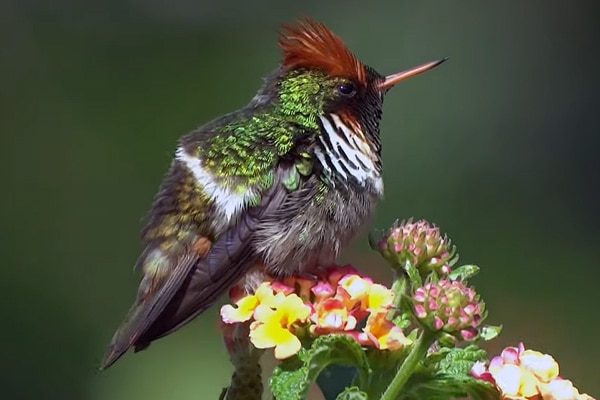Contents
- Frilled coquette facts
- How to Identify a Frilled coquette (hummingbird)
- Where you’ll See A Frilled coquette (Hummingbirds)
- Diet and Feeding Preferences of the Frilled coquette
- Frilled coquette nesting
- Frilled coquette Behavior
- Conservation Status of the Frilled coquette
- Fun & Interesting Facts about the Frilled coquette
- Explore More Species in This Family
The Frilled coquette is a hummingbird that also goes by the scientific name Lophornis magnificus. Not only is this bird remarkable in many ways, it’s also visually striking. It’s found throughout certain regions scattered throughout South America.
The most beautiful thing about this bird is its unique physical features and vibrant colors. In fact, bird enthusiasts and nature lovers consider the Frilled coquette a captivating sight to behold.
It’s definitely on the smaller side, measuring just 3.1-3.5 inches in length, but this small bird is quite popular and well-known for its intricate plumage. As far as the male members of the species go, they are the ones with the beautiful iridescent emerald-green body that reflects light and shimmers as the bird flits about.
But it’s most distinctive feature of all is the frill of elongated feathers that surround its neck, which provides elegance and it’s the reason why it has the Frilled coquette name. The frill is much more pronounced during courtship displays when the male hummingbird attempts to attract females by putting on aerial displays of an intricate nature.
Females have more subdued plumage, which is often the case would many hummingbirds. They have a touch of green and their upper parts but their feathers are primarily grayish-brown with a white or pale belly. Females do not have the same striking frill as their male counterparts.
Today, I’d like to tell you a lot more about the Frilled coquette hummingbird in greater detail. The topics that I intend to cover below include:
- Physical and character trait descriptions of Frilled coquettes
- The biggest differences between male and female Frilled coquettes
- Feeding preferences, dietary choices, nesting patterns, and migration practices of Frilled coquettes
- Other pertinent details regarding Frilled coquettes
Are you ready to discover everything you ever wanted to know about Frilled coquettes? Continue reading below to find out a plethora of new information about this incredibly small but lightning-fast Hummingbird from South America.
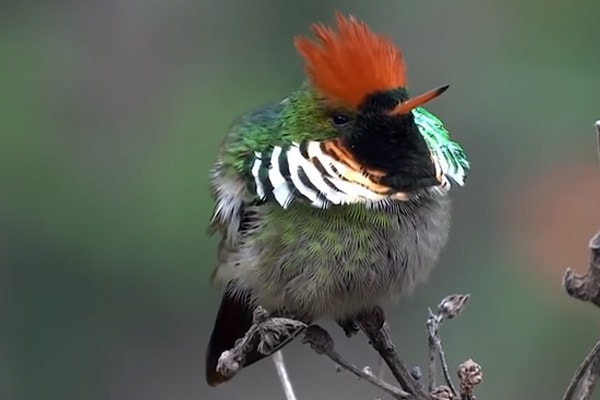
Frilled coquette facts
- Common Name: Frilled Coquette (Hummingbird)
- Scientific Name: Lophornis magnificus
- Scientific Family: Trochilidae
- Life Span: 5-6 years
- Size: 3.1 to 3.5 inches
- Wingspan: 3.9 to 4.3 inches
- Weight: 0.09 to 0.11 oz
- Conservation status: Least Concern
How to Identify a Frilled coquette (hummingbird)
To identify a Frilled coquette, we must focus on a number of key characteristics and other types of behaviors to make it easy to identify this bird. The areas to focus on include the following:
- Shape and Size – This is an important area to focus on because the frilled coquette is an incredibly small Hummingbird. It’s only 8-9 cm or 3.1-3.5 inches in total length. Its body is streamlined, and compact, and possesses the typical shape of your average Hummingbird.
- Behavior – These birds are incredibly active and quite agile to say the least. Their wings beat rapidly and very fast, which gives them the ability to hover in mid-air while sucking nectar out of their favorite flowers. They love hovering and they love darting from one flower to the next in very quick and speedy motions.
- Range – These birds are native to certain areas in South America. In particular, they are found throughout many parts of Brazil, Guyana, and Venezuela. If you happen to spend time in any of these areas, you’ll have a much better chance of encountering this bird species while visiting here when compared to anywhere else in the world.
- Habitat – The frilled coquette loves inhabiting forested habitats including montane forests and tropical lowland rainforests. If you intend to visit these regions in the future, you may end up finding frilled coquettes looking for flowering plants to devour the nectar.
Difference between the Male & Female Frilled coquette
There are many differences between male and female frilled coquettes. The main differences between both sexes include:
- Male Plumage – The plumage of the male frilled coquette Hummingbird is an iridescent emerald green on the upper parts, which also happens to be very vibrant in nature. The underside of the body is grayish-white in appearance, and the belly and throat area is typically pale by comparison. The most distinguishing of all of the male features is the elongated frilly feathers that circle around its neck. That’s what gives it the frilled appearance.
- Female Plumage – The female plumage differs a great deal when compared to the mail because it’s a lot more subdued and duller. For the most part, the upper parts of the female frilled coquette Hummingbird are mostly grayish-brown in appearance. They may have a slight touch of green, but nothing compared to the males. The underparts are typically pale or white, with a pale belly.
- Neck Frill – the male frilled coquette has a beautiful frilled pattern going all the way around its neck. Females do not possess this frill.
- Throat Coloration – males have a white throat patch, and females do not possess this distinguishing mark. The throat patch is typically white or slightly gray in color.
Besides physical appearance, the male and female frilled coquette both tend to maintain the same body size and shape.
Differences in Summer Plumage vs Winter Plumage of the Frilled coquette
The frilled coquette doesn’t actually undergo any major changes or molting between winter and summer seasons like some bird species. The males typically have vibrant colors that they maintain all year long along with their beautiful frill. The females also retain their average dull grayish-brown plumage with pale underparts throughout every season.
Where you’ll See A Frilled coquette (Hummingbirds)
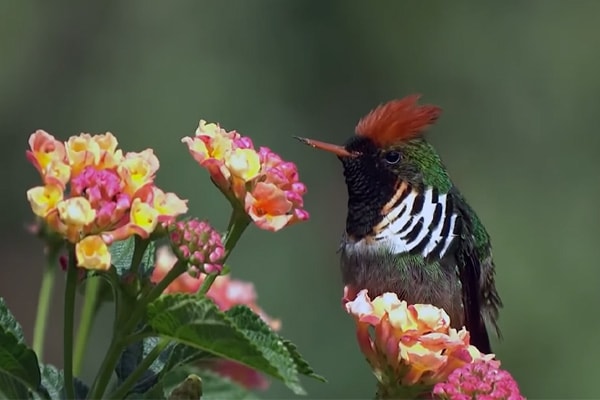
Frilled coquettes make certain regions of South America their home. The areas that you’ll typically find these birds within include the following:
- Venezuela – frilled coquettes love living in certain parts of Venezuela. In particular, they like living in the country regions of central and northern Venezuela. You’ll find them within the forested areas, and more specifically in the montane forests and tropical lowland rainforests.
- Guyana – these birds also live in certain parts of Guyana. They like forested areas in particular and tend to stick to habitats with lowlands and montane forests.
- Brazil – there is recorded proof that frilled coquettes love living in the forested regions of Brazil, including the Amazon rainforest. Most important of all, if you’re looking to encounter these hummingbirds, you’ll have an easier time finding them in the central and northern parts of this nation.
Please keep in mind that there is a limited distribution of frilled coquette hummingbirds within these countries. That’s why I keep pointing out very specific regions where these birds tend to live. Just remember that they love making forested habitats their home. Particularly, they thrive in habitats with lots of flowering plants, because nectar is their favorite source of food. Focus on areas with diverse vegetation if you’re looking to find these birds in suitable Hummingbird habitats.
To make your life easier, you should contact a local birdwatching guide when you attempt to visit these birds in their natural habitat. They’ll know exactly where to find frilled coquettes in abundance, so it’s always best to use local resources whenever possible.
Frilled coquette migration patterns
The frilled coquette does not undertake a long-distance migration. It is a nonmigratory bird that tends to reside within its preferred habitats all year round. It doesn’t make any significant movements from one geographic location to another.
Diet and Feeding Preferences of the Frilled coquette
As far as diet and feeding preferences are concerned, the frilled coquette is primarily known as a nectarivorous bird, which means it mainly feeds on nectar for sustenance and survival. But it isn’t the only source of energy that this bird will receive throughout the day. The main details about their diet and feeding preferences include:
- Nectar – For frilled coquettes, this is their primary source of sustenance and calories. Their bills are long and slender and specialized to reach deep within the heart of tubular flowers to gain access to sweet nectar. These birds are also considered pollinators because they managed to transfer pollen from one flower to another while feeding on nectar.
- Flower Preferences – The frilled coquette likes to visit certain flowers to obtain its nectar. In particular, it is attracted to tubular-shaped brightly colored flowers because they are drawn to their bright colors. A few examples of the favorite flowers of frilled coquettes include heliconias, bromeliads, orchids, sage, and lobelias to name some of their regular flowers to reward them with nectar.
- Insects and Spiders – Nectar makes up the bulk of their diet, but frilled coquettes will also supplement their diet and nutritional needs with spiders and small insects. These creatures provide them with protein and other nutrients to fuel these tiny birds that require lots of calories and energy to maintain their hovering and quick flying capabilities.
- Feeding Behavior – frilled coquettes are agile birds that have the ability to hover while feeding. They love to hover directly in front of flowers, which gives them the ability to extend their long bills deep inside the heart of the flower to reach the Corolla which gives them nectar. They’ll rapidly beat their wings to maintain a stable hover while feeding on their favorite flowers.
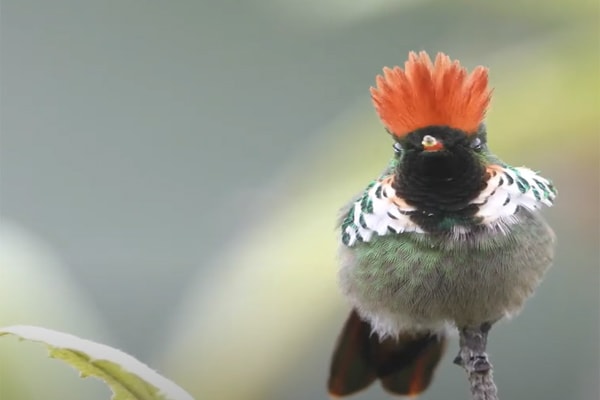
Frilled coquette nesting
- Clutch Size: 1-2 eggs
- # of Broods: 1-3 broods
- Incubation Period: 15-18 days
- Nestling period: 20-22 days
- Egg Description: White, slightly translucent
Like other hummingbirds, the Frilled coquette has instinctual nesting behaviors that it exhibits throughout the year during the breeding season.
Nest construction is undertaken by the male frilled coquette. He is responsible for gathering all of the nesting materials and then constructing the nest as well. He will gather spider silk, lichens, moss, and plant fibers to build a cup-shaped nest.
The male uses his long bill to his advantage, which he can use to weave and shape the material into a cup shape. Typically, the male also chooses the location of the nest, which he will build on a horizontal branch typically near dense vegetation or the trunk of a tree. This location is specifically chosen because it represents a sheltered environment for the nest that will provide protection from unwanted predators and other hummingbirds.
The female Frilled coquette will begin laying her eggs once the nest construction is complete. On average, her clutch size is anywhere from 1 to 2 eggs. It varies depending on each particular clutch. During this time, the female will then incubate the eggs for 15-18 days. She keeps the eggs warm and protected and shelters them from potential threats.
After the babies are born, they will undergo a nestling period that lasts for 20-22 days. The female will take care of her nestlings during this time until it’s time for them to begin fledging. Once they start to fledge, they will then learn to fly and eventually leave the nest.
The male frilled coquette also does a great job of taking care of his young hatchlings after they are born. Both males and females are responsible for providing food which comes in the form of small insects and regurgitated nectar. The parents are also quite territorial and will viciously and ferociously defend their nest against potential predators.
Frilled coquette Behavior
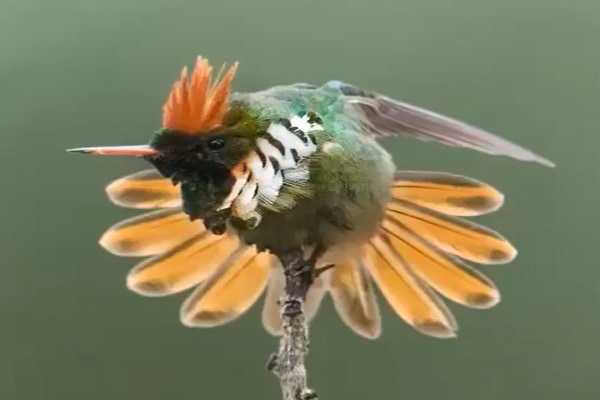
Besides specific nesting behaviors and other behaviors that I previously mentioned, I would like to dive deeper into some typical behaviors of the frilled coquette. Other unique behaviors and interesting characteristics displayed by frilled coquettes include:
- Ornamental Displays – The male frilled coquette has an ornamental frill of elongated feathers that circle all the way around its neck. When it is courting and attempting to get the attention of females during courtship displays, the male will extend his neck and vibrate his feathers, which creates a very distinctive and attractive frilled appearance. The females love these displays and they help males establish dominance over other males.
- Vocalizations – The frilled coquette has a wide range of vocalizations that it uses in an effort to communicate with other hummingbirds. It will initiate calls including buzzing sounds, chirping sounds, and other high-pitched sounds that will vary in intensity and tone based on the situation at hand. During courtship displays, males will also regularly produce specific vocalizations.
- Territorial Behavior – Frilled coquettes are staunch defenders of their territory. In particular, they will act aggressively and defend ferociously their areas containing lots of nectar-producing flowers. The males will engage in aerial chases and displays in an effort to scare away intruders. They also assert their dominance and establish territorial boundaries with specific vocalizations.
- Courtship Displays – During the breeding season, males will perform zigzag patterns, U-shaped flights, and swooping flights in an effort to attract females. These displays are specifically designed to showcase their vibrant plumage, and in particular to highlight their ornamental frill.
- Perching and Resting – Frilled coquettes spend a significant amount of time perched on branches when they aren’t protecting their territory or actively foraging for food. They tend to choose perches that are concealed within the shade and in an effort to avoid being detected by predators, they like to blend in with their surroundings.
Conservation Status of the Frilled coquette
According to the International Union for Conservation of Nature, which is the governing body tracking major conservation efforts, the frilled coquette Hummingbird is currently considered Least Concern. This means that this Hummingbird species isn’t under its population suddenly depleting any immediate threat of extinction. There is no immediate risk or danger of its population suddenly depleting. But authorities are monitoring climate change, habitat loss, deforestation, and food availability changes and their effects on Hummingbird populations including the population of the frilled coquette.
Fun & Interesting Facts about the Frilled coquette
- Small Hummingbirds – while the frilled coquette isn’t the smallest Hummingbird to ever exist, it is actually among the smallest of all hummingbirds throughout the world. Males only weigh roughly 3 g, which means these birds are incredibly lightweight.
- Frilled coquettes are endemic to South America and are native to the tropical regions in this area. They tend to live in countries that include Brazil, Guyana, and Venezuela.
- Frilled coquettes are generally a solitary species. Besides the breeding season, these birds tend to remain alone throughout the rest of the year. The males only come together with other members of their species a.k.a. females once it’s time to breed.
- The typical lifespan of the frilled coquette is relatively short. On average, this bird only lives 5-6 years. This is quite short when compared to other hummingbirds that can live for as many as 12 years.
- The frilled coquette breeding season lasts from August to March. Males will typically pursue females during the summer and show off their crest and plumage as a meeting display. After they have bred successfully, the female will typically lay to eggs and incubate them for 15-18 days.
Explore More Species in This Family
- Amethyst Woodstar (Calliphlox amethystina)
- Snowcap (Microchera albocoronata)
- Purple-crowned Fairy (Heliothryx barroti)
- Black-chinned Hummingbird (Archilochus alexandri)
- Black-throated Mango (Anthracothorax nigricollis)
- Black-breasted Puffleg (Eriocnemis nigrivestis)
- Ecuadorian Hillstar (Oreotrochilus chimborazo)
- Blue-throated Hummingbird (Lampornis clemenciae)
- Berylline Hummingbird (Amazilia beryllina)
- Sparkling Violetear (Colibri coruscans)
- White-necked Jacobin (Florisuga mellivora)
- Broad-tailed Hummingbird (Selasphorus platycercus)
- Bronze-tailed Plumeleteer (Chalybura urochrysia)
- Long-billed Hermit (Phaethornis longirostris)
- Magnificent Hummingbird (Eugenes fulgens)
- Allen’s Hummingbird (Selasphorus sasin)
- Long-tailed Hummingbird (Rhamphomicron longicauda)
- Little Woodstar (Chaetocercus bombus)
- Long-tailed Sylph (Aglaiocercus kingii)
- Violet Sabrewing (Campylopterus hemileucurus)
- Violet-headed Hummingbird (Klais guimeti)
- Shining Sunbeam (Aglaeactis cupripennis)
- Green-breasted Mango (Anthracothorax prevostii)
- White-bellied Woodstar (Chaetocercus mulsant)
- White-tailed Goldenthroat (Polytmus guainumbi)
- Black-crested Coquette (Lophornis helenae)
- Rufous Hummingbird (Selasphorus rufus)
- Booted Racket-tail (Ocreatus underwoodii)
- Ruby-topaz Hummingbird (Chrysolampis mosquitus)
- Ruby-throated Hummingbird (Archilochus colubris)
- Fiery-throated Hummingbird (Panterpe insignis)
- Crowned Woodnymph (Thalurania colombica)
- Anna’s hummingbird (Calypte anna)
- White-vented Plumeleteer (Chalybura buffonii)
- Plain-capped Starthroat (Heliomaster constantii)
- Xantus’s Hummingbird (Hylocharis xantusii)
- Violet-crowned Hummingbird (Amazilia violiceps)
- Brazilian Ruby (Clytolaema rubricauda)
- Red-billed Streamertail (Trochilus polytmus)
- Green Thorntail (Discosura conversii)
- Calliope Hummingbird (Selasphorus calliope)
- Cinnamon Hummingbird (Amazilia rutila)
- Buff-bellied Hummingbird (Amazilia yucatanensis)
- Gorgeted Woodstar (Chaetocercus heliodor)
- Costa’s Hummingbird (Calypte costae)

